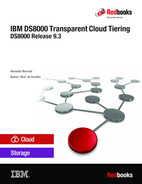

Using automatic migration
This chapter describes the automatic migration function and cloud usage.
The automatic migration is performed as part of primary space management, interval, or on-demand migration tasks. The ability to automatically select data that is eligible for cloud migration is vital to maximize central processing unit (CPU) savings that are related to data migration in DFSMShsm.
This chapter describes the following topics:
10.1 SMS support for automatic migration
To enable the DFSMShsm automatic migration to cloud, it is necessary to define the policies that define one of the following targets for migration of a data set:
•The existing Migration Level 2 (ML2) volumes
•The defined cloud storage that is configured to your systems
The definitions for data set migration are included in the SMS Management Class construct. Therefore, new fields are included to allow storage administrators to define conditions that are required for a data set to be eligible for cloud migration.
10.1.1 Management Class updates
The data sets cannot be automatically migrated from ML2 to cloud the same way that Migration Level 1 (ML1) data sets can be migrated to ML2. So, the management class was updated to create the rules for deciding the migration level tier.
The following fields are now available on Management Class under the Migration Attributes panels:
•Level 2 Days Non-usage
Specifies a direct migration to cloud storage. Current possible values are 0 and NOLIMIT.
A blank value also indicates NOLIMIT. A value of NOLIMIT indicates that a data set migrates to Level 2 based on the value of Level 1 Days Non-usage.
A value of 0 for this attribute indicates that the data set migrates to the cloud storage specified by the Cloud Name field if the Primary Days Non-usage value is met and the data set still is on Level 0.
The Level 2 Days Non-usage processing takes precedence over the Level 1 Days Non-usage value. The default value is NOLIMIT.
•Size LTE
The “Size Less than or equal” field shows the low data set size threshold in tracks. It is used to take the action described in the Action LTE field.
•Action LTE
The value in the Action LTE column shows which action to perform if the data set size is less than or equal to Size LTE. The following values are possible:
– NONE: No action is taken.
– ML1: Target migration level is ML1.
– ML2: Target migration level is ML2 regardless of the values for LEVEL 1 DAYS NON-USAGE.
– MIG: Target migration level is ML1 or ML2 according to the value of LEVEL 1 DAYS NON-USAGE.
– TRANS: Data set transition.
– CLOUD: Target migration level is CLOUD.
If no value is specified, DFSMShsm performs the migration action the same way it is performed today.
•Size GT
The “Size Greater than” field shows the high data set size threshold in tracks. It is used to take the action described on “Action GT” field.
•Action GT
The value in the Action GT column shows which action to perform if the data set size is greater than Size GT. The following values are possible:
– NONE: No action is taken.
– ML1: Target migration level is ML1.
– ML2: Target migration level is ML2 regardless of the values for LEVEL 1 DAYS NON-USAGE.
– MIG: Target migration level is ML1 or ML2 according to the value of LEVEL 1 DAYS NON-USAGE.
– TRANS: Data set transition.
– CLOUD: Target migration level is CLOUD.
If no value is specified, DFSMShsm performs the migration action the same way it is performed today.
•Cloud Name
The value in the CLOUD NAME shows the name of a previously defined cloud construct for the data set migration to the cloud during automatic migration (Primary Space Management, Interval migration, and On-Demand migration).
The new fields work in a way that is similar to the existing DFSMShsm data set migration exit (MD), which controls the migration level for data sets selected by automatic migration processing. You can configure these fields by using these values in the exit, and you can disable the exit.
Table 10-1 Valid installation exit module names and their meanings
|
Module Name
|
Abbreviation
|
Meaning
|
|
ARCMDEXT
|
MD
|
Data set migration exit
|
|
Note: If you have the DFSMShsm MD exit on, it overrides the values that are used in the management class construct.
|
EXITON is an optional SETSYS command parameter specifying active installation exits in the DFSMShsm primary address space. For modname, substitute the module name of the installation exit that you want to be active.
For more information about exiting, see the following website:
10.2 Storage Group affinity enhancements
The use of cloud storage by DFSMShsm can affect the length of your space management windows, as your migration to the cloud can take longer than ML1/ML2 migrations depending on your network usage, latency, and cloud performance.
For some large systems, with several storage groups and DFSMShsm images running, storage administrators might decide to spread the workload between these Hierarchical Storage Manager (HSM) images. There are enhancements to the storage group affinity to allow the selection of storage groups management for specific HSM hosts.
To enable the storage group affinity, you can use the new SETSYS command to identify the storage groups that are managed by an HSM host. Example 10-1 shows a sample SETSYS command to create the affinity between storage group BATCH1 and the HSMIMG2 DFSMShsm image.
Example 10-1 Sample STORAGEGROUPAFFINITY command
F HSMIMG2,SETSYS STORAGEGROUPAFFINITY(BATCH1)
By setting up the storage group affinity, the specific HSM usage manages the defined storage groups. Define this command in your ARCCMD parmlib member to save your settings across initial program loads (IPLs).
The SETSYS MIGRATIONAUTOCLOUD parameter enables the host to run cloud migration, and is an optional parameter that defines the possible target tier during automatic migration. The default value of this parameter is NOCLOUD:
•ALL: Specifying that data set migration to ML1, ML2, transition, and migration to cloud storage are performed.
•CLOUDONLY: Specifying that only data set migration to cloud storage is performed, as shown in Example 10-2.
•NOCLOUD: Specifying that only data set migration to ML1, ML2, and transition are performed.
Example 10-2 Specifying that only data set migration to cloud storage is performed
SETSYS MIGRATIONAUTOCLOUD(CLOUDONLY)
10.3 Space management functions
This section describes the space management functions for managing SMS-managed storage, which is updated with cloud information:
•Automatic primary space management
•Automatic secondary space management
Automatic primary space management
During automatic primary space management, the following events occur:
•All DFSMShsm hosts delete temporary data sets and expired data sets from the DFSMShsm-managed volumes that they are processing. This operation is done under the control of the management class that is associated with each data set on the volume or the expiration date that is contained in the data set’s volume table of contents (VTOC) entry.
•Under control of the data set management classes, all DFSMShsm hosts release unused allocated space in physical sequential, partitioned, and extended format Virtual Storage Access Method (VSAM) data sets.
•During data set and volume processing, fast subsequent migration reconnects eligible data sets to the ML2 tape or cloud from which they were most recently recalled.
•Under the extent reduction function, all DFSMShsm hosts also reduce the number of extents of physical sequential, partitioned, and direct-access data sets that exceed a specified number of extents. During the process of extent reduction, they also release any unused space in the data sets and compress partitioned data sets.
•Data sets that are eligible for a class transition are moved. If a data set is eligible for both a class transition and migration, the data set is migrated only, which prevents the data set from being moved from one level 0 volume to another for a transition, only to be later migrated to a migration volume.
•Data sets that are eligible for migration are migrated.
Primary space management continues until the SMS-managed volumes have the specified amount of available space. However, if deletion of expired data sets, fast subsequent migration, and space reduction of the remaining data sets achieves the specified volume available space low threshold, no actual data sets are moved.
If data sets are migrated during primary space management, they are migrated in compacted form if possible. Data sets that are expected to be smaller than 110 KB (where 1 KB is 1024 bytes) after they are compacted are candidates for small data set packing (SDSP) if enabled.
Automatic secondary space management
Automatic secondary space management schedules TAPECOPY commands for migration tape copy needed (TCN) records, deletes expired data sets from the migration volumes, deletes obsolete MCDs, VSRs, and DSRs during migration cleanup, and moves data sets (under control of the management class) from ML1 to ML2 volumes.
On the first day of the secondary space management cycle, DFSMShsm examines the containers in the clouds that are defined to DFSMShsm, looking for containers that do not have objects. Any empty containers are deleted. If the end of the Secondary Space Management window is reached and not all containers are examined, the processing continues in the next Secondary Space Management window.
Others space management considerations
When DFSMShsm processes an SMS-managed volume for space management, it records the time at which the volume was processed for cloud or non-cloud migrations. If another DFSMShsm host attempts to process the same volume for space management to cloud or non-cloud migrations, it checks the time at which the volume was last processed. If the volume was processed within the last 14 hours, DFSMShsm does not process the volume again for that type of target. A volume can be processed by one host for non-cloud migrations, and later processed by another host for cloud migrations.
Under Tasks for automatic space management, Specifying the DFSMShsm hosts that process each storage group, see 10.2, “Storage Group affinity enhancements” on page 106.
..................Content has been hidden....................
You can't read the all page of ebook, please click here login for view all page.
